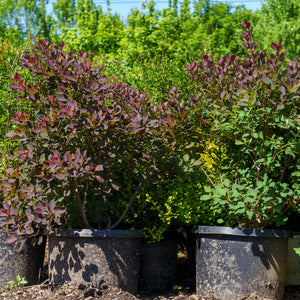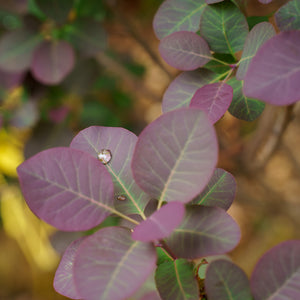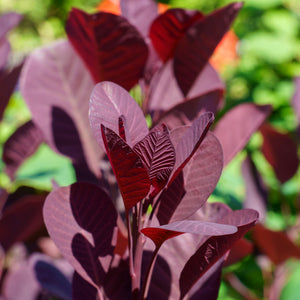The Smokebush Guide
Smokebush (Cotinus spp.) is a bold, ornamental shrub prized for its dramatic foliage, smoky flower plumes, and multi-season appeal. Known for its airy inflorescences that resemble puffs of smoke, smokebush is a standout in both formal and informal gardens. With cultivars available in rich purples, bright greens, and golden hues, this versatile shrub brings dynamic contrast and texture to any planting scheme.
About
The genus Cotinus includes a few species, but most commonly grown are Cotinus coggygria (European smokebush) and Cotinus obovatus (American smoketree). Cotinus coggygria is widely cultivated for its colorful leaves and distinctive flower heads that create a smoky haze in summer. Popular cultivars include 'Royal Purple', known for its deep burgundy foliage; 'Winecraft Black', a compact form with near-black leaves; and 'Golden Spirit', also known as 'Ancot', with bright chartreuse foliage that glows in the landscape.
Cotinus obovatus, native to the southeastern United States, is less common in cultivation but is notable for its large size and spectacular fall color. The hybrid Cotinus x 'Grace' blends the best traits of both species, offering vigorous growth and vivid seasonal interest.
Smokebush is not just about showy blooms. Its foliage is attractive throughout the growing season, transitioning from vibrant spring colors to bold summer shades and fiery fall tones. In addition to their visual appeal, smokebush plants are drought tolerant once established and low maintenance, making them a practical yet artistic choice for modern landscapes.
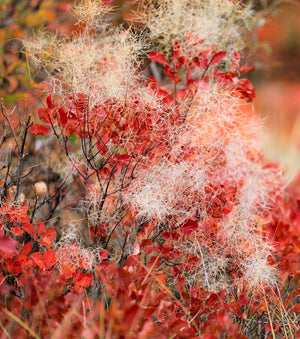
PLANTING
USDA Hardiness Zones: Generally hardy in Zones 4–9, depending on variety. Some cultivars may be best suited for Zones 5–8.
Soil: Prefers well-drained, moderately fertile soils. Tolerant of a wide range of soil types including rocky or clay soils, as long as drainage is good.
Sunlight: Full sun (6+ hours daily) is ideal for the most vibrant foliage color and abundant flowering. Some varieties tolerate light shade but may become leggy or muted in color.
Watering: Regular watering during establishment. Once established, smokebush is drought tolerant and prefers to dry slightly between waterings.
Spacing: Space plants according to mature size. Compact varieties like 'Velveteeny' may need 4–6 feet, while larger cultivars like 'Grace' may require 10–15 feet.
Planting Time: Spring or early fall is ideal, allowing the plant to establish before extreme heat or cold.
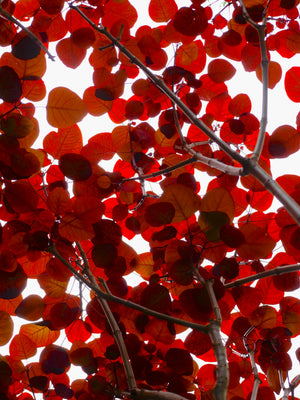
CARE
Watering: Water deeply during dry spells, especially in the first year. Established plants can go longer between waterings but benefit from occasional deep soaking.
Fertilizing: Smokebush generally requires little fertilizer. A light application of balanced fertilizer in early spring can encourage new growth.
Pruning: Prune in late winter or early spring before new growth emerges. Smokebush can be pruned lightly to maintain a natural shape or cut back hard to encourage vibrant new foliage and control size. It can also be trained into a small multi-stemmed tree by removing lower branches over time.
Pests and Diseases: Smokebush is relatively pest-free but may occasionally encounter verticillium wilt or leaf spot. Ensure proper spacing and avoid overwatering to reduce disease risk.
Mulching: Apply a 2–3 inch mulch layer around the base to retain moisture and regulate soil temperature, keeping mulch a few inches away from the stem.
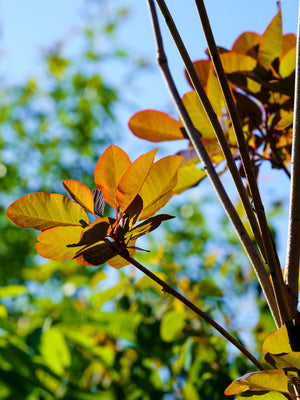
HOW TO USE
Focal Point: Smokebush shines as a focal point thanks to its unique shape, bold foliage, and ethereal flower clouds. Use it to anchor a border, draw the eye in an open lawn, or frame an entrance.
Mixed Borders: Pair purple cultivars like 'Royal Purple' or 'Winecraft Black' with silver or chartreuse companions such as Perovskia, Artemisia, or golden ornamental grasses to create striking contrast.
Mass Planting and Hedges: Use compact varieties like 'Winecraft Gold' or 'Velveteeny' in groupings or as informal hedges where their uniform growth and color will stand out.
Modern and Architectural Gardens: The structured form and bold foliage color of smokebush make it a perfect complement to modern garden designs. Combine with upright evergreens, dark-stemmed shrubs, or gravel plantings for a contemporary effect.
Fall Color Displays: Smokebush adds dramatic fall foliage in shades of orange, red, and scarlet. Combine with shrubs like Itea virginica, Fothergilla, or Viburnum for a rich autumn tapestry.
Wildlife and Low-Maintenance Gardens: Though not a major pollinator plant, smokebush contributes shelter and habitat in naturalistic designs and thrives with minimal care once established.
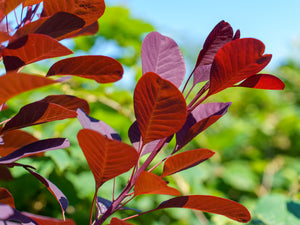
Common Questions
How to prune smokebush? Prune in late winter to early spring. Light pruning maintains shape, while hard pruning encourages dense, colorful foliage and controls size. Smokebush can also be trained into a small tree form.
How to propagate smokebush? Take semi-hardwood cuttings in summer or propagate by layering. Seeds can be used but require stratification and patience.
Is smokebush evergreen? No, smokebush is deciduous and loses its leaves in fall.
Is smokebush native? Cotinus obovatus is native to the southeastern U.S., while Cotinus coggygria is native to Europe and Asia.
When to prune smokebush? Late winter to early spring, before new growth begins.
Can I prune smokebush into a tree? Yes, remove lower branches gradually over several seasons to expose main trunks and create a tree-like form.
Do deer eat smokebush? Smokebush is generally considered deer resistant.
Is smokebush toxic to dogs or cats? Smokebush is not listed as toxic by the ASPCA, but ingestion may cause mild digestive upset. Best practice is to discourage pets from chewing any landscape plants.
Can smokebush tolerate shade? It can tolerate partial shade but performs best in full sun where foliage color is most vibrant.
How fast does smokebush grow? Smokebush grows at a moderate rate, typically 1 to 2 feet per year depending on conditions and cultivar.
Conclusion
Smokebush offers gardeners a bold blend of foliage, flower, and form. Whether grown as a colorful accent shrub, pruned into a sculptural tree, or layered into a mixed border, Cotinus delivers high-impact color with relatively low upkeep. With many sizes and shades available, it’s easy to find a variety that will bring drama and depth to any landscape plan.
The Smokebush Collection
Sold Out
Sold Out
Sold Out

